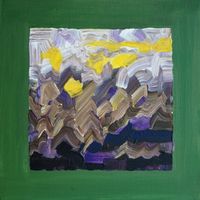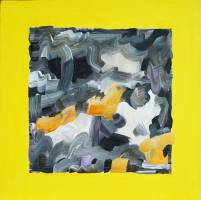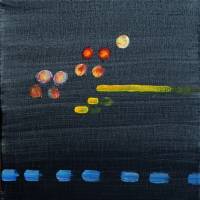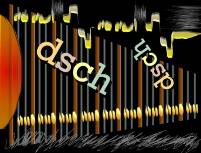Paintings related to symphonies by Dmitri Shostakovich
The complex instrumentation of the fifteen symphonies composed by Dmitri Shostakovich is particularly suitable to stimulate visual synesthetic phenomena. My first three pictures shown here are related to sheets of sound, which are agglomerated by the polyphonic interaction of numerous instruments. The colored boundary area expresses a perceived background color. The inner area follows the format of Kazimir Malevich’s “Black Square” and thus connects the music back to the origins of modernism.
Figure 1 is related to the beginning of the second symphony, with a dense network of string parts, with brass sounds in orange and the bass tuba solo in dark blue. Figure 2 shows a polyphonic part of the second movement, with colorful contributions of various types of wind instruments. The short section of orchestral noise shown in figure 3 includes orange brass sounds, black timbales and off-white cymbals, taken from the fourth symphony.
Figure 1. “Polyphonic aggregation I” - 30x30cm, acrylic on cardboard, 2019. From: Symphony No. 2 B major, Op. 14 “To October”, first movement, score section 1-13.
Figure 2. “Polyphonic aggregation II” - 30x30cm, acrylic on cardboard, 2019. From: Symphony No. 2 B major, Op. 14 “To October”, second movement, score section 39-52.
Figure 3. “Fortissimo I” - 30x30cm, acrylic on cardboard, 2019. From: Symphony No. 4 C minor, Op. 43, first movement, ~7’15”-7’27”.
Figure 4 shows a fast upward movement of the higher strings. Figure 5 depicts celesta tones and trumpet sound, accompanied by a soft bass rhythm at the end of this symphony.
Figure 4. “Upturn” - 10x20cm, acrylic on cardboard, 2019. From: Symphony No. 4 C minor, Op. 43, first movement, ~15’35”-16’00”.
Figure 5. “Silent End” - 19x19cm, acrylic on cardboard, 2019. Single instrument sounds from: Symphony No. 4 C minor, Opus 43, end of fourth movement, ~26’00”-26’14”.
In the fourth movement of the fifteenth symphony Shostakovich quotes motifs composed by Richard Wagner. The brass motif of “fate” is depicted in the lower left part of figure 6. After that, some tones of the motif of “longing and desire” taken from “Tristan and Isolde” follow, shown by a yellow band. This motif surprisingly changes into a light and elated melody, which is interrupted by the motif of fate.
Figure 6. “Wagner Motifs” - 24x18cm, acrylic on cardboard, 2019. From: Symphony No. 15 A major, Op. 141, score section 110-114.
Figure 7 shows a rhythmic section of the tenth symphony. Shostakovich codes the initials of his name into a music motif, which comprises the tones D-Es-C-H. If I consciously translate the motif back into these letters, they immediately appear on my inner monitor with colors according to my color-grapheme synesthesia.
Figure 7. “dsch” - 30x42cm, print on paper, 2019. From: Symphony No. 10 E minor Op. 93, third movement, ~7’20”-7’28”.
Michael Haverkamp, 2019






